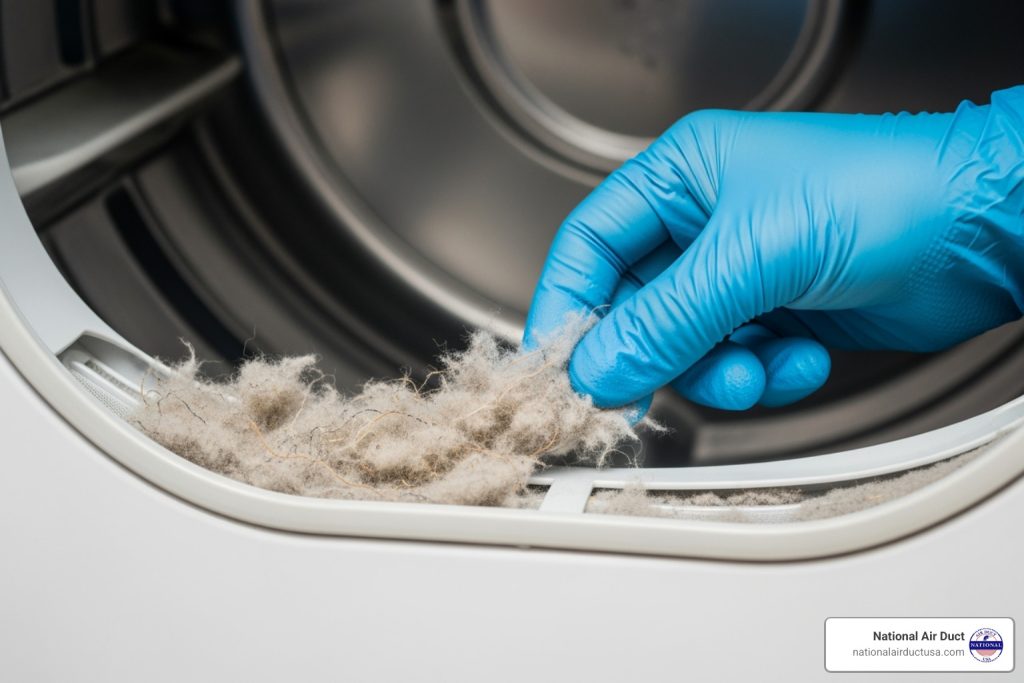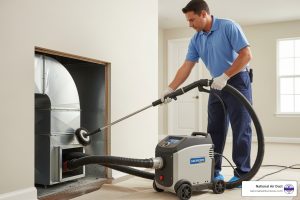Why Dryer Fire Prevention Is Critical for Your Home’s Safety
Dryer fire prevention starts with understanding a sobering reality: every year, clothes dryers cause approximately 15,000 home fires, resulting in 13 deaths, 440 injuries, and over $200 million in property damage. These aren’t just statistics – they represent real families whose lives were forever changed by a preventable tragedy.
Quick Dryer Fire Prevention Checklist:
- Clean lint filter after every load
- Inspect exterior vent monthly for blockages
- Schedule professional cleaning annually
- Use rigid metal ducts instead of plastic
- Never leave dryer running when away or sleeping
- Watch for warning signs like longer drying times or burning smells
The most alarming fact? About 27% of these fires are caused by something as simple as lint buildup – highly flammable material that naturally accumulates in your dryer and venting system. As one fire safety expert puts it: “A leading cause of dryer fires in the home is the lack of dryer maintenance.”
Your laundry room might seem like one of the safest spaces in your home, but it’s actually one of the biggest fire hazards. The good news is that most dryer fires are completely preventable with proper maintenance and awareness.
The National Fire Protection Association reports that clothes dryers are responsible for 92% of all laundry room fires. Yet many homeowners remain unaware of the simple steps that could save their homes and families.

The Hidden Dangers: Understanding Dryer Fire Risks
Your laundry room hides serious fire risks that many homeowners overlook. Understanding these dangers is the first step in effective dryer fire prevention.
The primary risk is lint buildup. Beyond the lint trap, lint accumulates in the dryer’s venting system, where it restricts airflow, causing the dryer to work harder and overheat. Other significant risks include:
- Mechanical and Electrical Failures: A faulty thermostat, worn heating element, or frayed wiring can cause excessive heat or sparks that ignite lint.
- Crushed Hoses and Blockages: Hoses crushed behind the unit restrict airflow and trap heat. Nests from animals in the outdoor vent can also cause a complete blockage.
- Improper Installation: Using incorrect venting materials, creating a vent path that’s too long, or including too many bends can lead to dangerous conditions that often go unnoticed for years.
For more comprehensive information on dryer safety, the National Fire Protection Association offers excellent resources to help keep your home protected.
The #1 Culprit: Why Lint is So Dangerous
Lint is highly flammable due to its composition of tiny, dry fibers from cotton and synthetics. This material has a massive surface area, making it easy to ignite from a small spark or high heat.
Lint’s danger lies in its proximity to the dryer’s heat source. The heating element can reach temperatures hot enough to ignite any accumulated lint. Every time you run your dryer, some lint escapes the filter and travels into the exhaust system, where it accumulates in ducts.
This buildup eventually blocks airflow, trapping hot, moist air inside the dryer. This creates a dangerous cycle: the lint buildup causes the dryer to overheat, and the overheating can ignite the lint.

The statistics tell the story: about 27% of all dryer fires are directly caused by lint accumulation. Even more sobering is that over one-third of dryer fires happen because homeowners failed to clean their dryer’s venting and lint trap. This makes diligent lint management absolutely critical for dryer fire prevention.
5 Warning Signs Your Dryer is a Fire Hazard
Your dryer will often signal when something is wrong. Recognizing these warning signs early can prevent a minor issue from becoming a major disaster.
- Longer drying times: If clothes take longer to dry or require multiple cycles, airflow is likely restricted. This puts extra stress on your dryer and increases fire risk.
- A burning smell: An odor of burnt toast or scorched lint means lint is overheating. Turn off the dryer immediately and have it inspected.
- Dryer exterior is hot: If the outside of the dryer is unusually hot to the touch, heat is not escaping properly through the vent.
- Clothes are hot after the cycle: Laundry that comes out scorching hot indicates your dryer is overheating due to restricted airflow.
- Vent hood flap doesn’t open: Check the flap outside your home while the dryer is running. If it stays closed, you have a blockage. Also look for lint accumulating around the opening.
If your machine shuts down unexpectedly mid-cycle, it could be a safety mechanism triggered by overheating. Don’t ignore these warnings.
For more information on dealing with these issues, visit our page on dryer vent clog removal.
Your Essential Guide to Dryer Fire Prevention
Now that we understand the risks, let’s focus on prevention. Dryer fire prevention is not complicated, but it requires consistency. Think of it as a simple routine that becomes second nature. Effective dryer safety is an ongoing commitment, not a one-time fix.
Do This: Essential Cleaning and Maintenance for Dryer Fire Prevention
Most dryer fire prevention comes down to simple, straightforward tasks. Knowing what to clean and when is the secret to safety.
| What to Clean | How Often | Why |
|---|---|---|
| Lint Filter | Every Load | Prevents immediate lint buildup on clothes and within the dryer, crucial for efficient drying and fire prevention. |
| Dryer Vent Duct | Annually | Removes hidden, highly flammable lint that bypasses the filter and accumulates in the ductwork, ensuring proper airflow. |
| Dryer Cabinet | Annually | As per manufacturer’s instructions, prevents internal lint accumulation around electrical components and heating elements. |
| Exterior Vent | Seasonally/Monthly | Ensures the outdoor flap opens freely and prevents blockages from debris, snow, or animal nests, maintaining exhaust flow. |
- Clean your lint filter after every single load. This 10-second task dramatically reduces the amount of lint that can escape into the vent system. Once a month, scrub the screen with a nylon brush and soapy water to remove fabric softener buildup.
- Clean the filter housing where the filter slides in. Use a dryer lint brush or vacuum attachment to remove accumulated fuzz.
- Clean behind your dryer at least twice a year. Pull the dryer away from the wall and vacuum thoroughly, checking that the vent hose isn’t damaged, crushed, or kinked.
- Check your exterior vent monthly. Ensure the vent cover opens freely when the dryer is running and clear away any debris.
For homeowners who want to go deeper, our residential dryer vent cleaning service provides the thorough, professional cleaning that keeps your system running safely and efficiently.
Don’t Do This: Critical Mistakes to Avoid
Avoiding a few critical mistakes is just as important for dryer fire prevention.
- Never overload your dryer. Overloading restricts airflow, forces the dryer to work harder, and creates more lint. Follow your manufacturer’s load size guidelines.
- Don’t leave your dryer running unattended, especially overnight or when away from home. If a fire starts, you need to be present to detect it and take action.
- Be careful with flammable materials. Never put items in the dryer that have touched gasoline, cooking oils, paint thinner, or alcohol. Vapors can ignite from the heat. Similarly, items made of foam, rubber, or plastic can melt or catch fire. Wash items stained with flammable chemicals multiple times and air dry them away from heat sources. For more detailed information, check out these key facts.
- Don’t ignore warning signs like longer drying times or burning smells. These are serious safety alerts that demand immediate attention.
- Never use your dryer without a lint filter or with a damaged one. Replace a worn or damaged filter immediately.
Choosing the Right Materials for Dryer Fire Prevention
The type of venting material you use is critical for safety. Not all ducts are created equal.

- Rigid metal ducts are the gold standard. Made from aluminum or steel, their smooth interiors minimize lint buildup and maximize airflow. They are durable and resist crushing.
- Flexible metal ducts are an acceptable second choice for short connections. These semi-rigid aluminum ducts are fire-resistant but can trap more lint and are more prone to crushing.
- Avoid plastic or foil accordion-style ducts at all costs. These are dangerous. Their accordion design traps lint, and they sag, crush, and puncture easily, creating ideal conditions for a fire. If you have these, replace them immediately with metal alternatives.
When connecting duct sections, use metal clamps and foil tape. Never use sheet-metal screws inside the duct, as they catch lint. Keep vent runs as short and straight as possible to improve airflow and reduce lint buildup.
If you’re unsure about your ductwork or need professional installation, our dryer vent replacement service ensures your system meets all safety standards.
When to Call in the Professionals
Let’s be honest – while we love a good DIY project, there are times when it’s best to step back and let the experts handle things. Dryer fire prevention is one of those areas where professional help can make all the difference between a safe home and a dangerous situation.
Think of it this way: you wouldn’t rewire your entire house yourself, right? The same principle applies to your dryer’s ventilation system. Professional services offer specialized tools, years of experience, and a level of thoroughness that’s simply hard to match with a weekend project and a hardware store brush kit.
There are also some very real safety concerns that come with DIY dryer vent cleaning. Long ductwork runs, complex routing through walls, and the potential for carbon monoxide exposure with gas dryers are all situations where professional expertise becomes invaluable. Plus, the energy efficiency benefits you’ll see from a properly cleaned and maintained system often pay for the service itself.
The Importance of Professional Installation and Servicing
When it comes to dryer fire prevention, professional installation isn’t just a nice-to-have – it’s your foundation for years of safe operation. We’ve seen too many well-intentioned DIY installations that created more problems than they solved.
Correct electrical connections are absolutely critical, especially for electric dryers. One wrong wire or an ungrounded connection can turn your laundry room into a fire hazard. Professional technicians know exactly which plugs and outlets to use, and they’ll ensure everything meets current electrical codes.
The proper venting path is another area where professionals really shine. They’ll map out the shortest, straightest route to the outdoors – which means less lint buildup and better airflow. More importantly, they know how to secure ducts properly so you won’t have any surprise disconnections or crushing that could block your exhaust.
For gas dryers, professional installation becomes absolutely non-negotiable. Gas line integrity isn’t something to mess around with. A qualified technician will ensure every connection is properly sealed and safe, preventing dangerous gas leaks that could lead to carbon monoxide poisoning.
Professional installers also follow the manufacturer’s instructions to the letter. This might sound basic, but you’d be surprised how many problems stem from skipping a step or making assumptions about how something should work.
For more details on maintaining your dryer’s integrity, explore our dryer vent repair services.
Annual Dryer Vent Inspections and Cleaning
Here’s the thing about lint – no matter how diligent you are with your daily cleaning routine, it’s going to find its way into the hidden corners of your vent system. That’s just the nature of the beast. This is where annual professional cleaning becomes your secret weapon for dryer fire prevention.

A professional dryer vent cleaning goes way beyond what you can accomplish with a brush kit from the hardware store. Our NADCA-certified technicians at National Air Duct USA use specialized equipment that can reach deep into your vent system, including those tricky bends and long runs that are impossible to access otherwise.
Lint removal from the entire duct run is the heart of what we do. We’re talking about extracting all that stubborn, hidden lint that bypasses your filter and settles in the darkest corners of your ductwork. This is the lint that poses the biggest fire risk because it’s out of sight and out of mind.
But we don’t stop there. Airflow testing ensures your dryer is exhausting properly after cleaning, which means faster drying times and lower energy bills. We also check for damage or disconnections throughout the system – things like crushing, kinks, holes, or sections that have come apart and are leaking lint into your walls.
The peace of mind that comes with professional cleaning is honestly priceless. Knowing that your dryer’s exhaust system is clean, intact, and functioning optimally lets you focus on more important things – like whether your teenager actually put their clean clothes away.
For more information on what an inspection entails, visit our page on dryer vent inspection.
Frequently Asked Questions about Dryer Safety
We get a lot of questions about dryer safety. Here are the answers to the most common ones to help you with your dryer fire prevention efforts.
How often should I really have my dryer vent professionally cleaned?
While the general rule is at least once a year, the ideal frequency depends on your usage.
You may need cleaning every 6-9 months if you have:
- A large family with constant laundry.
- Pets that shed, as hair significantly adds to lint buildup.
- A long or complex vent path with several turns, which allows more places for lint to get stuck.
Stick to an annual cleaning as a baseline, but if you notice warning signs like longer drying times, don’t wait. Call a professional right away.
Can I clean the dryer vent myself?
Yes, you can and should perform basic cleaning and maintenance. This includes cleaning the lint filter after every load and vacuuming around the dryer.
DIY dryer vent cleaning kits can be effective for short, straight vent runs. However, they often can’t reach the entire length of a complex system or remove stubborn, compacted lint.
A professional cleaning is more thorough. Technicians use specialized tools to clean the entire system and can spot hidden problems you might miss, such as crushed ducts, disconnections, or improper installation. Your DIY efforts are necessary, but professional service ensures maximum safety and efficiency. For more information on professional repairs, visit our page on dryer vent repair.
Are electric or gas dryers more dangerous?
Statistics show electric dryers are more than 2.5 times more likely to cause fires, often due to higher heat generation that can ignite lint buildup.
However, gas dryers have their own serious risk: carbon monoxide poisoning. A blocked vent or improper installation can cause this deadly, odorless gas to leak into your home.
The bottom line is that proper maintenance is crucial for both types. For gas dryers, ensure professional installation and regular inspections of the gas line. We also strongly recommend installing both smoke alarms and carbon monoxide alarms in your home and testing them monthly.
Conclusion: A Simple Routine for a Safer Home
The core message of dryer fire prevention is simple: a little routine maintenance can save your home and family. A few straightforward habits can make all the difference.
Key takeaways for a safer home include:
- Clean your lint filter after every load. This is the single most effective habit for preventing lint buildup.
- Upgrade to rigid metal ducts. Avoid flimsy plastic or foil accordion-style ducts, which are a known fire hazard.
- Never leave your dryer running unattended, especially when you are asleep or away from home.
- Pay attention to warning signs like longer drying times or burning smells. These are signals that your dryer needs immediate attention.
While daily care is crucial, professional maintenance is essential for long-term safety. An annual visit from a NADCA-certified professional provides the deep cleaning needed to remove hidden fire risks. At National Air Duct USA, we know this not only improves safety but also boosts energy efficiency, saving you money on utility bills.
Dryer fire prevention is about taking simple, proactive steps. By adopting these practices, you are actively protecting your home and family. Don’t wait for a warning sign. Take proactive steps today to ensure your dryer remains a reliable appliance, not a hidden hazard.
Explore our professional dryer vent cleaning services and let us help you create a simple, safe routine for complete peace of mind.



